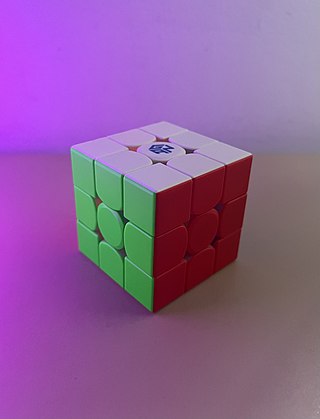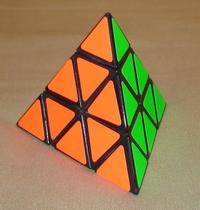
The Rubik's Cube is a 3D combination puzzle invented in 1974 by Hungarian sculptor and professor of architecture Ernő Rubik. Originally called the Magic Cube, the puzzle was licensed by Rubik to be sold by Pentangle Puzzles in the UK in 1978, and then by Ideal Toy Corp in 1980 via businessman Tibor Laczi and Seven Towns founder Tom Kremer. The cube was released internationally in 1980 and became one of the most recognized icons in popular culture. It won the 1980 German Game of the Year special award for Best Puzzle. As of January 2024, around 500 million cubes had been sold worldwide, making it the world's bestselling puzzle game and bestselling toy. The Rubik's Cube was inducted into the US National Toy Hall of Fame in 2014.
A puzzle is a game, problem, or toy that tests a person's ingenuity or knowledge. In a puzzle, the solver is expected to put pieces together in a logical way, in order to achieve the correct solution of the puzzle. There are different genres of puzzles, such as crossword puzzles, word-search puzzles, number puzzles, relational puzzles, and logic puzzles. The academic study of puzzles is called enigmatology.

The Rubik's Revenge is a 4×4×4 version of the Rubik's Cube. It was released in 1981. Invented by Péter Sebestény, the cube was nearly called the Sebestény Cube until a somewhat last-minute decision changed the puzzle's name to attract fans of the original Rubik's Cube. Unlike the original puzzle, it has no fixed faces: the center faces are free to move to different positions.

Rubik's Magic, like the Rubik's Cube, is a mechanical puzzle invented by Ernő Rubik and first manufactured by Matchbox in the mid-1980s.

Speedcubing, also referred to as speedsolving, is a competitive sport centered around the rapid solving of various combination puzzles. The most prominent puzzle in this category is the 3x3x3 puzzle, commonly known as the Rubik's Cube. Participants in this sport are known as "speedcubers," who focus specifically on solving these puzzles at high speeds, or more generally as "cubers". The essential aspect of solving these puzzles typically involves executing a series of predefined algorithms in a particular sequence.

The Professor's Cube is a 5×5×5 version of the original Rubik's Cube. It has qualities in common with both the 3×3×3 Rubik's Cube and the 4×4×4 Rubik's Revenge, and solution strategies for both can be applied.

The Pyraminx is a regular tetrahedron puzzle in the style of Rubik's Cube. It was made and patented by Uwe Mèffert after the original 3 layered Rubik's Cube by Ernő Rubik, and introduced by Tomy Toys of Japan in 1981.

Sudoku is a logic-based, combinatorial number-placement puzzle. In classic Sudoku, the objective is to fill a 9 × 9 grid with digits so that each column, each row, and each of the nine 3 × 3 subgrids that compose the grid contains all of the digits from 1 to 9. The puzzle setter provides a partially completed grid, which for a well-posed puzzle has a single solution.

Mathematics can be used to study Sudoku puzzles to answer questions such as "How many filled Sudoku grids are there?", "What is the minimal number of clues in a valid puzzle?" and "In what ways can Sudoku grids be symmetric?" through the use of combinatorics and group theory.

This is a glossary of Sudoku terms and jargon. Sudoku with a 9×9 grid is assumed, unless otherwise noted.

Uwe Mèffert was a German puzzle designer and inventor. He manufactured and sold mechanical puzzles in the style of Rubik's Cube since the Cube craze of the 1980s. His first design was the Pyraminx – which he had developed before the original Rubik's Cube was invented. He created his own puzzle company and helped bring to market the Megaminx, Skewb, Skewb Diamond and many other puzzles.

The Rubik's Revolution is a handheld electronic game invented, designed, developed and patented by Rehco, LLC, a Chicago toy and game inventing firm. The Rubik's Revolution was formerly distributed by Techno Source and received the 2008 TOTY Game of the Year Award. 11-12 years later, it would be revamped by Techno Source's parent company, Super Impulse and be regarded as one of the many toys that would help battle boredom in the Covid-19 Pandemic according to Time To Play Mag Designed to resemble the classic Rubik's Cube puzzle, the device is a single rigid cube; it is about as large as a Professor's Cube, with each face subdivided into 9 square sub-faces. The center square of each face features a recessed LED-lit button colored to correspond with the stickers on the remaining squares. Gameplay involves pressing the buttons when they light up, or when directed to by the game's recorded voice.

KenKen and KenDoku are trademarked names for a style of arithmetic and logic puzzle invented in 2004 by Japanese math teacher Tetsuya Miyamoto, who intended the puzzles to be an instruction-free method of training the brain. The name derives from the Japanese word for cleverness. The names Calcudoku and Mathdoku are sometimes used by those who do not have the rights to use the KenKen or KenDoku trademarks.

The V-Cube 7 is a combination puzzle in the form of a 7×7×7 cube. The first mass-produced 7×7×7 was invented by Panagiotis Verdes and is produced by the Greek company Verdes Innovations SA. Other such puzzles have since been introduced by a number of Chinese companies, some of which have mechanisms which improve on the original. Like the 5×5×5, the V-Cube 7 has both fixed and movable center facets.
The Rubik's Triamid is a mechanical puzzle invented by Ernő Rubik and released in 1990 by Matchbox. The puzzle was patented in Hungary in 1991. It was re-released in 2017 at the American International Toy Fair by Winning Moves.

RuBot II is a Rubik's Cube solving robot developed by Irish roboticist and inventor Pete Redmond. RuBot II is also known as RuBot II, the Cubinator. RuBot II became the world's fastest Rubik's Cube-solving robot, and appeared as such in the Guinness Book of World Records. There are other Rubik's Cube robots too.

Str8ts is a logic-based number-placement puzzle, invented by Jeff Widderich in 2008. It is distinct from, but shares some properties and rules with, Sudoku. The name is derived from the poker straight. The puzzle is published in a number of newspapers internationally, in two book collections, and in downloadable apps. It was featured on the Canadian television show Dragons' Den on November 24, 2010.

Tony Fisher is a British puzzle designer who specialises in creating custom rotational puzzles. He is acknowledged by cubing enthusiasts as a pioneer in the creation of new puzzle designs and new manufacturing techniques. In 2017 the Guinness Book of World Records acknowledged Fisher as the creator of the world's largest Rubik's cube.

The Nine-Colour Cube is a cubic twisty puzzle. It was invented in 2005 by Milan Vodicka and mass-produced by Meffert's seven years later. Mechanically, the puzzle is identical to the Rubik's Cube; however, unlike the 3×3×3 Rubik's Cube, which only has 6 different colours, the Nine-Colour Cube has 9 colours, with the individual pieces having one colour each.

The Gear Cube is a 3-D combination puzzle designed and created by Dutch puzzle maker Oskar van Deventer based on an idea by Bram Cohen. It was initially produced by Shapeways in 2009 and known as "Caution Cube" due to the likelihood of getting one's fingers stuck between the gears while speedcubing. Later, in 2010, it was mass-produced by Meffert's as the "Gear Cube".




















